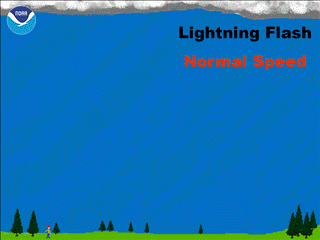If additional negative charge is immediately available in the cloud in the vicinity of the initial return stroke, the additional charge may start to move toward ground in the conductive path left by the initial return stroke. These subsequent leaders are called dart leaders. Because the channel is already established, the charge can move down the main channel in a much smoother manner than the stepped leader, and at a much greater speed (Figure 1). Like the stepped leader, another return stroke will occur when they reach the ground. Because dart leaders just follows the main discharge channel, subsequent return strokes are not usually branched.
Typically, a negative flash of lightning will be comprised of an initial stepped leader/return stroke followed by 2 or 3 subsequent dart leaders/return strokes. Multiple return strokes will cause the lightning to flicker. While not all negative flashes have more than one return stroke, some negative flashes have been observed with more than a dozen return strokes.
Figure 2 shows the various components of a lightning flash including the stepped leader, positive streamers, the return stroke, and three dart leaders/return stokes.
All of this happens in a fraction of a second (Figure 3) and cannot be discerned by the human eye which is overwhelmed by the bright return stroke.
 |
 |
 |
| Figure 1 | Figure 2 | Figure 3 |
Learn about Slow Motion Video Of Lightning Flashes or return to Contents page